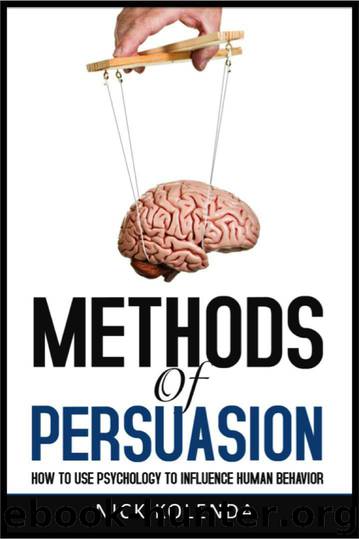Methods of Persuasion: How to Use Psychology to Influence Human Behavior by Kolenda Nick

Author:Kolenda, Nick [Kolenda, Nick]
Language: eng
Format: mobi, epub, azw3
Tags: human behavior, Psychology, Marketing, influence, Self Help, consumer behavior, advertising, persuasion
Published: 2013-11-16T14:00:00+00:00
He saved up his money and bought a boat.
The stormy seas tossed the boat.
The researchers presented those two sentences to people and asked them to focus solely on the last word (i.e., “boat”) and rate it on a pleasantness scale. Even though the question was essentially the same, people who were exposed to the second sentence rated “boat” to be significantly more pleasant (Whittlesea, 1993).
That result occurred because of conceptual fluency, a type of processing fluency related to how easily information comes to our mind (Alter & Oppenheimer, 2009). Generally, the faster a concept enters our mind, the more we tend to like it. Because the second sentence used particular words to prime the context, this heightened predictability caused the concept of “boat” to enter people’s minds more easily, and that ease of processing produced a pleasant feeling that became misattributed to the word “boat.”
Top-level marketers spend millions of dollars each year trying to take advantage of conceptual fluency. If we’re deciding between two possible brands to purchase, we’re likely to base our decision on how easily each brand comes to mind. When our opinion of two brands is the same, we’re more likely to purchase the brand that comes to our mind more easily because that heightened conceptual fluency feels pleasant, and we mistakenly attribute that pleasantness to the brand (Nedungadi, 1990).
Marketers can take advantage of conceptual fluency and enhance the effectiveness of their advertisements by strategically positioning their ads in predictive contexts. For example, one study showed that consumers found a ketchup ad more favorable when the ad was presented after an ad for mayonnaise (Lee & Labroo, 2004). The mayonnaise ad primed consumers’ schema for condiments, and when the ad for ketchup was presented afterward, the idea of ketchup came to their minds more easily. As a result of that heightened conceptual fluency, consumers developed a more positive attitude toward the ketchup advertisement.
How can you apply that technique in your own life? You can increase your chances of persuading someone to comply with a request by casually mentioning the topic of your request immediately prior to making it. Similar to the mayonnaise ad, the general topic will increase your target’s conceptual fluency for your request, and as a result, your request will seem more appealing because it will come to your target’s mind more easily. Your target will then misattribute that ease of processing with a desire to comply with your request.
Suppose that your favorite band is coming to town, and you want to persuade your friend to go to the concert with you next month. However, your friend doesn’t really like the band, so you expect to encounter some resistance. In this situation, don’t rush and hastily make your request now; instead, periodically bring up the idea of concerts in general for the next few days. With repeated exposure to that general topic, your friend will gradually develop a more positive attitude toward concerts in general, and he will be less resistant when you make your actual request.
Download
Methods of Persuasion: How to Use Psychology to Influence Human Behavior by Kolenda Nick.epub
Methods of Persuasion: How to Use Psychology to Influence Human Behavior by Kolenda Nick.azw3
This site does not store any files on its server. We only index and link to content provided by other sites. Please contact the content providers to delete copyright contents if any and email us, we'll remove relevant links or contents immediately.
Rewire Your Anxious Brain by Catherine M. Pittman(18553)
Talking to Strangers by Malcolm Gladwell(13222)
The Art of Thinking Clearly by Rolf Dobelli(10223)
Mindhunter: Inside the FBI's Elite Serial Crime Unit by John E. Douglas & Mark Olshaker(9201)
Becoming Supernatural by Dr. Joe Dispenza(8119)
Change Your Questions, Change Your Life by Marilee Adams(7635)
Nudge - Improving Decisions about Health, Wealth, and Happiness by Thaler Sunstein(7615)
The Road Less Traveled by M. Scott Peck(7522)
The Lost Art of Listening by Michael P. Nichols(7408)
Enlightenment Now: The Case for Reason, Science, Humanism, and Progress by Steven Pinker(7235)
Mastermind: How to Think Like Sherlock Holmes by Maria Konnikova(7227)
Win Bigly by Scott Adams(7094)
The Way of Zen by Alan W. Watts(6506)
Daring Greatly by Brene Brown(6447)
Big Magic: Creative Living Beyond Fear by Elizabeth Gilbert(5614)
Grit by Angela Duckworth(5523)
Ego Is the Enemy by Ryan Holiday(5294)
Men In Love by Nancy Friday(5156)
Altered Sensations by David Pantalony(5045)
